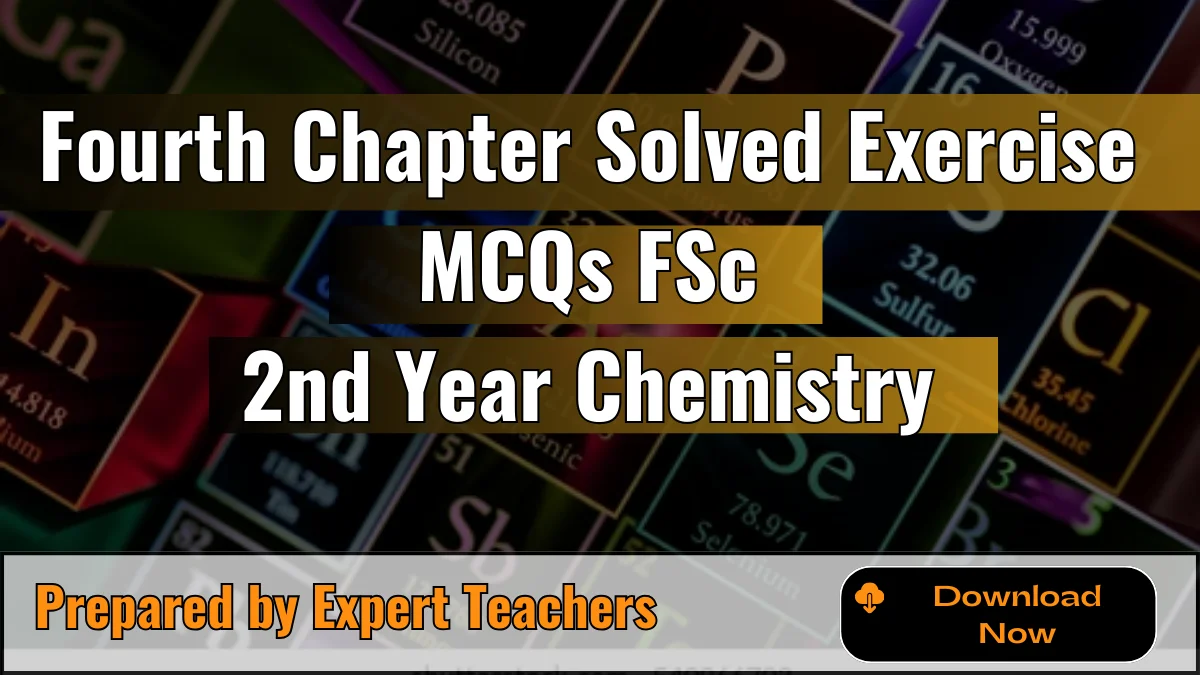15th Chapter Solved Exercise MCQs of FSC Second Year Chemistry
The 15th Chapter Solved Exercise MCQs of FSC 2nd-year Chemistry provides a complete set of solved multiple-choice questions (MCQs). Each MCQ comes with a brief explanation to help you understand the correct answer. These solutions are designed to support students in preparing for their exams, making complex concepts easier to grasp and ensuring a solid foundation for success.
15th chapter solved MCQs with explanation
1. Which three elements are needed for the healthy growth of plants?
(a) N, S, P
(b) N, Ca, P
(c) N, P, K
(d) N, K, C
Explanation: Option (c) is correct. Because N (Nitrogen) is essential for leaf growth and overall plant vigor as it’s a key component of proteins and chlorophyll.
- P (Phosphorus) helps in root development, energy transfer, and photosynthesis.
- K (Potassium) is important for regulating various plant processes, including water uptake and enzyme activation.
These three elements are known as macronutrients and are crucial for the healthy growth and development of plants.
2. Which woody raw material is used for the manufacture of paper pulp?
(a) Cotton
(b) Bagasse
(c) Poplar
(d) Rice straw
Explanation: Option (c) is correct. Because Poplar is a type of wood commonly used in the manufacture of paper pulp. It is chosen because it has a high cellulose content and fibers that are suitable for making paper. Cotton and bagasse are used in paper production but not primarily for making pulp. Rice straw is also used but less commonly than poplar.
3. The nitrogen present in some fertilizers helps plants:
(a) to fight against diseases
(b) to produce fat
(c) to undergo photosynthesis
(d) to produce protein
Explanation: Option (d) is correct. Because Nitrogen is a crucial component of amino acids, which are the building blocks of proteins. Plants need nitrogen to synthesize these amino acids, and thus, to produce proteins. Proteins are essential for growth and development in plants.
4. Phosphorus helps the growth of:
(a) root
(b) leave
(c) stem
(d) seed
Explanation: Option (d) is correct. Because Phosphorus is crucial for the development of seeds because it is a key component of ATP (adenosine triphosphate), which is essential for energy transfer and storage in plants. It also helps in the formation of DNA and RNA, which are vital for cell division and growth. Thus, phosphorus supports seed development and overall plant growth.
5. Micro-nutrients are required in quantity ranging from:
(a) 4-40g
(b) 6-200g
(c) 6-200kg
(d) 4-40kg
Explanation: Option (a) is correct. Because Micronutrients are essential nutrients that are required in very small quantities compared to macronutrients. They typically range from a few milligrams to a few grams per day. The quantity of micronutrients required is far less than the quantities listed in the other options, which are too high.
6. During the manufacturing process of cement the temperature of the decomposition zone goes up to:
(a) 600°C
(b) 800°C
(c) 1000°C
(d) 1200°C
Explanation: Option (d) is correct. Because during the manufacturing process of cement, specifically in the decomposition zone of the kiln, the temperature typically reaches around 1200°C. At this high temperature, the raw materials like limestone (calcium carbonate) decompose into lime (calcium oxide) and carbon dioxide. This process is crucial for forming the clinker, which is then ground to make cement.
7. The word paper is derived from the name of which reedy plant:
(a) Rose
(b) Sun flower
(c) Papyrus
(d) Water Hyacinth
Explanation: Option (c) is correct. Because the word “paper” comes from the Greek word “papyrus,” which was a reedy plant used by ancient Egyptians to make a type of writing material. The papyrus plant was crucial in early paper-making processes, and the term eventually became associated with the paper we use today.
8. Which is not a calcarious material?
(a) lime
(b) clay
(c) marble
(d) marine shell
Explanation: Option (b) is correct. Because calcareous materials are those that contain calcium carbonate (CaCO₃). Lime (calcium oxide), marble, and marine shells all contain calcium carbonate, making them calcareous. Clay, on the other hand, is primarily composed of silicate minerals and does not contain significant amounts of calcium carbonate.
9. How many zones through which the charge passes in a rotary kiln?
(a) 4
(b) 3
(c) 2
(d) 5
Explanation: Option (b) is correct. Because in a rotary kiln, the charge passes through three distinct zones:
- Drying Zone: Where moisture is evaporated from the charge.
- Calcining Zone: Where the chemical reactions (like calcination) occur, transforming the charge into a more reactive form.
- Sintering Zone: Where the final heating causes the charge to form a solid product, usually by melting or binding together. These zones are crucial for processing materials effectively in a rotary kiln.
10. Ammonium nitrate fertilizer is not used for which crop?
(a) Cotton
(b) Wheat
(c) Sugar cane
(d) Paddy rice
Explanation: Option (d) is correct. Because ammonium nitrate fertilizer is rich in nitrogen, which can lead to overgrowth and poor yield in paddy rice. Rice paddies, often flooded, need a more balanced nutrient approach rather than high-nitrogen fertilizers. Thus, ammonium nitrate is not typically used for paddy rice.







Leave a Reply